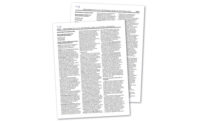USDA withdraws GIPSA rules on unfair practices
The Department of Agriculture’s (USDA) Grain Inspection, Packers and Stockyards Administration (GIPSA), Packers and Stockyards Program (P&SP) is notifying the public that after review and careful consideration of the public comments received, GIPSA will take no further action on the proposed rule published on December 20, 2016.
The explanation, as attributed to Acting GIPSA Administrator Randall D. Jones, is below:
On December 20, 2016, GIPSA published in the Federal Register (81 FR 92703) and invited comments on a proposed rule to amend the regulations issued under the Packers and Stockyards Act (P&S Act) (7 U.S.C. 181 – 229c). GIPSA intended that the proposed rule would clarify the conduct or action that GIPSA considers unfair, unjustly discriminatory, or deceptive in violation of 7 U.S.C. 192(a). The proposed rule also identified criteria that the Secretary would use to determine if conduct or action by packers, swine contractors, or live poultry dealers constitutes an undue or unreasonable preference or advantage in violation of 7 U.S.C. 192(b). GIPSA published a document in the February 7, 2017, Federal Register (82 FR 9533) to extend the comment period for the proposed rule from February 21, 2017, to March 24, 2017. GIPSA received 866 comments on the proposed rule.
Commenters opposing the proposed rule stated that the purpose of the P&S Act is to protect competition, not individual competitors or market participants. The commenters commonly claimed that the proposed rule would increase litigation industry-wide. Commenters stated that if the requirement to show harm to competition was no longer applicable, the proposed rule would embolden producers and growers to sue for any perceived slight by a packer, swine contractor, or live poultry dealer. Commenters also pointed out that the proposed rule contains vague terms and phrases including: “legitimate business justification,” “retaliatory action,” “similarly situated,” “reasonable time to remedy,” “arbitrary reason,” and “but is not limited to.”
They argued that those terms and phrases are overbroad and create ambiguity regarding the conduct or action that would be permitted or prohibited. They speculated that this ambiguity would lead to broad interpretations that would make compliance difficult, and that this uncertainty would generate litigation.
Also, commenters noted that the proposed rule conflicts with case law in multiple U.S. Courts of Appeals that have ruled that 7 U.S.C. 192(a) and (b) only authorize a cause of action if the conduct at issue harms, or is likely to harm, competition. The Department of Justice (DOJ) filed amicus briefs with several of these courts, but DOJ’s legal arguments failed to persuade the courts. Commenters further wrote that at least two of these U.S. Courts of Appeals are unlikely to grant deference to the proposed rule if finalized. Also, commenters argued that Congress considered and ultimately declined to enact legislation in 2007 that would have overturned the judicial decisions interpreting 7 U.S.C. 192(a) that require a showing of harm or likely harm to competition.
Producers, growers, and farm trade groups generally supported the proposed rule, with some exceptions. Commenters who expressed support often noted that many farmers invest millions of dollars of their own money on new — or upgrades to existing — production facilities in order to meet the contractual demands of packers, swine contractors, or live poultry dealers. Many wrote that farmers need the proposed rule to protect them from unfair, deceptive, or retaliatory practices that can cause farmers to lose their operations and investments. These commenters stated that this proposed rule provided long overdue protection to farmers and clarified to the industry the conduct or action that is a violation of the P&S Act.
The proposed rule closely relates to the interim final rule (IFR) published in the Federal Register (81 FR 92566) on December 20, 2016, which stated that conduct or actions can violate 7 U.S.C. 192(a) or (b) of the P&S Act without a finding of harm or likely harm to competition.
In the IFR, GIPSA formalized its longstanding interpretation of 7 U.S.C. 192(a) and (b). In the preamble to the proposed rule, GIPSA explained that the rule was consistent with the IFR because proposed 9 CFR 201.210(b) and 201.211 give examples of conduct that does not require likelihood of harm to competition to violate 7 U.S.C. 192(a) and (b). GIPSA withdrew the IFR because, among other reasons, it is inconsistent with court decisions in several Courts of Appeals and those courts are unlikely to give GIPSA’s interpretation deference.
As the comments noted, this proposed rule, like the IFR, conflicts with legal precedent in several Circuits. These conflicts pose serious concerns. GIPSA is cognizant of the commenters who support allowing the proposed rule and their concerns regarding the imbalance of bargaining power Also, we recognize that the livestock and poultry industries have a vested interest in understanding what conduct or actions violate 7 U.S.C. 92(a) and (b). This proposed rule, however, would inevitably generate litigation in the livestock and poultry industries. Protracted litigation to both interpret this regulation and defend it serves neither the interests of the livestock and poultry industries nor GIPSA.
Also, as the preamble to the proposed rule noted: “For several decades, GIPSA has brought administrative enforcement actions against packers for violations of the regulations under the P&S Act without demonstrating harm or likely harm to competition. ” In the proposed rule itself, GIPSA linked the proposed rule to practices that are already violations of the regulations and statute, such as 9 CFR 201.82, and 7 U.S.C. 228b. GIPSA also predicted that the proposed rule would not increase administrative enforcement actions against packers because GIPSA designed the regulations to follow its current interpretation of 7 U.S.C. 192(a) and (b). On the other hand, some commenters wrote that the breadth of the proposed regulation would suppress innovative contracting because regulated entities would fear the increased risk of litigation presented by ambiguous terms in the proposed rule. As stated previously, commenters noted producers and growers might be emboldened to sue for any perceived slight.
Executive Order 13563 directs, as a matter of regulatory policy, that USDA identify and use the best, most innovative, and least burdensome tools for achieving regulatory ends; to account for benefits and costs, both quantitative and qualitative; and to tailor its regulations to impose the least burden on society, consistent with obtaining regulatory objectives. To the extent the proposed rule codified longstanding practice, the prescriptions of the proposed rule could have the unintended consequence of preventing future market innovations that might better accommodate rapidly evolving social and industry norms. In the past, GIPSA has approached the elimination of specific unfair and deceptive practices on a case-by-case basis. Continuing this approach will better foster market-driven innovation and evolution, and is consistent with the obligation to promote regulatory predictability, reduce regulatory uncertainty, and identify and use the most innovative and least burdensome tools for achieving regulatory ends.
Therefore, after review and careful consideration of the public comments received, GIPSA will take no further action on the December 20, 2016, proposed rule referenced above.
Source: USDA
Looking for a reprint of this article?
From high-res PDFs to custom plaques, order your copy today!





